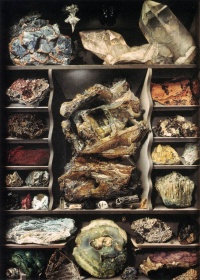Mining
From The Art and Popular Culture Encyclopedia

|
Related e |
|
Featured: |
Mining is the extraction of valuable minerals or other geological materials from the earth, from an orebody, lode, vein, (coal) seam or reef, which forms the mineralized horizon and package of economic interest to the miner.
To gain access to the mineralised package within the lease area (aka Mining Rights Lease) it is often necessary to mine through (to create access, shafts, addits, ramps) or remove to the side waste material which is not of immediate interest to the miner. The total movement of ore and waste, which also includes the removal of soil in some cases, is referred to as the mining process. Depending on the nature, attitude, and grade of the orebody, it is often the case that more waste than ore is mined during the course of the life of a mine. The waste removal and placement is a major cost to the mining operator and to facilitate detailed planning the detailed geological and mineralisation characterization of the waste material forms an essential part of the geological exploration programme.
The waste is classified as either sterile or mineralised (with acid generating potential) and the movement and stacking (or dumping) of this material forms a major part of the mine planning process. In cases where the mineralised package is determined by an economic cut-off, the near grade mineralised waste is dumped separately with view to treatment should market conditions change and it becomes economic viable to treat this material. Civil engineering design parameters are used in the design of the waste dumps, and special conditions apply to high-rainfall areas, e.g. Brazil or Venezuela, or where the dumps are created in seismically active areas like Chile, Peru, and parts of Canada. In addition, the waste dump designs must meet with all regulatory requirements of the country in whose jurisdiction the mine is located. It is also common practice for major mining companies to do the rehabilitation of the dumps to an international acceptable standard, which in some cases means that higher standards than the local regulatory standard are applied.
The materials of economic interest (aka as ore) recovered by mining include base metals, precious metals, iron, uranium, coal, diamonds, limestone, oil shale, rock salt and potash. Mining is required to obtain any material that cannot be grown through agricultural processes, or created artificially in a laboratory or factory. Mining in a wider sense comprises extraction of any non-renewable resource (e.g., petroleum, natural gas, or even water).
Mining of stone and metal has been done since pre-historic times. Modern mining processes involve prospecting for ore bodies, analysis of the profit potential of a proposed mine, extraction of the desired materials and finally reclamation of the land to prepare it for other uses once the mine is closed.
The nature of mining processes creates a potential negative impact on the environment both during the mining operations and for years after the mine is closed. This impact has led to most of the world's nations adopting regulations to moderate the negative effects of mining operations. Safety has long been a concern as well, though modern practices have improved safety in mines significantly.
See also
- Automated mining
- Mining engineering
- Outline of mining
- Landfill mining
- List of uranium mines
- Mineral industry
- Spoil tip
- Asteroid mining
- Galena Experiment
Region specific:
- Mineral industry of Africa
- Colourful lakelets (in Poland)
- Mining in Sierra Leone
- Mining and metallurgy in medieval Europe
- Mining in the Upper Harz
- Mining in Cornwall and Devon
- Canadian Mining Hall of Fame
- National Mining Hall of Fame (USA)

